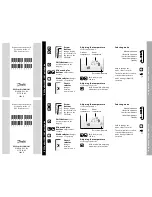
Flickering / oscillating ammeter and panel lights
.
Check the connections between the Alternator Bat termi-
nal and the pin A input to the controller for high resis-
tance, corrosion, dirt, loose or intermittent connection..
No voltage regulation
With the engine off and the Master switch on. Pins I, A,
and S should measure Battery voltage, pin F should be
0.5 to 2V less the bus voltage.
•
If the measured voltage is different, see The volt-
ages on pins I, A, S should equal bus’ on page 3
for probable causes for the problem.
•
If the pin F voltage is the same as the bus voltage,
look for and correct open circuit or high resistance
in the alternator’s field or the wire between the
field and pin F. The controller might not be prop-
erly grounded.
•
If the pin F voltage is 0V and pins I, A, S have
battery voltage, look for a grounded alternator
field or field wire. If the field resistance is correct
as shown in step 5 of the installation tests, send the
ACU in for test/repair. If there is a field ground
fault, repair it or replace the defective alternator.
•
If the pin F voltage is correct, verify that the field
resistance and the condition of the connections and
wires between the ACU and the field are good.
Bus voltage remains at battery voltage (about 12V)
To solve this problem, see
No voltage regulation.
Alternator carries only about half its rated output
.
Look for an open stator wire or open diode in the
alternator. Check the shunts and alternator output wires
indicating an alternator that is current limiting.
Bus voltage drops with load increase
To solve this problem, see
Alternator carries only about
half its rated output
and or the condition of the wire/
connections between pin A and the alternator Bat
terminal
.
LV-OV light does not work, everything else works
Disconnect the ACU. Turn on the Bat switch. Ground
pin I. The light should illuminate. If it does not, the lamp
is defective or the wires to or from it are broken
By Femi G. Ibitayo
©2003, Z
EFTRONICS
,
Tovya Group Inc
R15100-PIT.pub. Pg 4/4
ZEFTRONICS
Electrical Charging Systems Solutions
1622 E. Whaley St., Longview, TX 75601. USA
Ph: 903-758-6661; Fax: 903-236-9766. E-mail: [email protected]
Ph: 1-800-362-8985. Web Site
:
www.zeftronics.com
Frequently Asked Questions & T
ECH
C
ARD
Notes
14V Type B alternator system on Beech, Cessna, Grumman, Maule, etc
T
ROUBLE
-
SHOOTING
THE
SYSTEM
O
UR
GOAL
IS
TO
HELP
YOUR
SYSTEM
OPERATE
BETTER
AND
HELP
YOU
BETTER
UNDERSTAND
ITS
OPERATION
.
I
NSTALLATION
T
ESTS
.
BEFORE
INSTALLING
THIS
UNIT
,
PERFORM
TESTS
:
1. Read pages 1 to 3 and this page.
2. Check for and replace open, frayed, or broken wires. Clean thor-
oughly or replace corroded, dirty, or oxidized connections, terminals,
contact, or poorly soldered wire junction.
3. Check for Open or Ground-shorted alternator field. Most 12V alter-
nators have 3-6
Ω
field resistance. Ground shorted alternator field
will damage most Voltage Regulators/ACU. Repair or replace an
alternator has a field to ground short, do not connect the ACU to it.
4. With the engine off: Check voltage drops across the Field, Alt
switch, Alt field circuit breaker and ACU. High voltage-drop means
excessive junction resistance and will lead to many problems like:
fluctuation ammeters, charge-meters and panel lights.
5. Perform and record the following tests with the
Master
Switch
Off
:
12V Values Typical Values
A. Field resistance at ALT
__________
Ω
3 – 6
Ω
B. Field resistance at ACU
__________
Ω
3 – 6
Ω
C. Field SW/C-BKR resistance __________
Ω
0 – 0.1
Ω
D. ALT Bat to Pin A resistance __________
Ω
0 – 0.05
Ω
E. ALT Out C/BKR resistance
__________
Ω
0 – 0.05
Ω
6. Perform and record the following tests with the
Master
Switch
On
:
Engine Off
Bat Switch on Alt Switch on Typical Values
A. Bus Voltage __________V __________V
12 – 13V
D. Pin I Voltage __________V __________V
12 – 13V
E. Pin A Voltage __________V __________V
12 – 13V
F. Pin S Voltage __________V __________V
12 – 13V
F. Field Voltage __________V __________V 0.5-2V <VBus
7.
Post Installation.
If all tests are correct to or per steps 5 & 6, run
the engine and record:
12V System Typical value
A.
Bus voltage
__________V 13.8 – 14.3V
For tech help & other TechCards, call:
903-758-
6661
© Z
EFTRONICS
, 2002
Z
EFTRONICS
Electrical
Charging
System
Solutions
Z
EFTRONICS
T
ECH
C
ARDS
In this
Type B
system: the controller is between the Bus and the
Alternator’s field. To control the bus voltage, the unit switches power
to the field several times a second. The OVS opens when OV occurs.
B
60A
or X
A
Alt Fld
BUS BAR
Alt Out
A
LT
F
LV-OV Light
2A
Alt
ACU
Relay
I
-
B
AT
+
Ba
t Re
lay
Bat
A
F
VR
Red
OVS
Orange
S
Z
EFTRONICS
: S
OLUTIONS






















